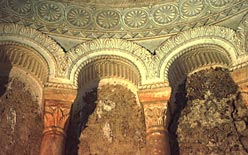 Arcade in Sainte-Trinité, Germigny. © Alison Stones Images of Medieval Art & Architecture |
|
||
An arcade {ahr-kayd'} is a range or series of two or more arches borne by piers or columns and may be either freestanding or blind. An arcade supported on columns is also called a colonnade. Freestanding arcades were developed early in Roman Architecture and were widely used throughout the empire. They formed the supporting walls of amphitheaters, such as the Colosseum in Rome, and were used by the mile in aqueducts, such as the Pont-du-Gard in Nîmes, France, which employs three tiers of arcades to bridge a deep valley.
If an arcade is attached to a wall, or if the openings are filled with masonry, it is called a blind arcade. Such an arcade may strengthen the wall but often serves a decorative purpose as well. Blind arcades originated in Rome, were used extensively in Early Christian and Byzantine architecture, and adorn Romanesque, Gothic, Renaissance, and Neoclassical buildings. The term arcade has also come to mean a roofed gallery lined with shops, amusement concessions, and restaurants.